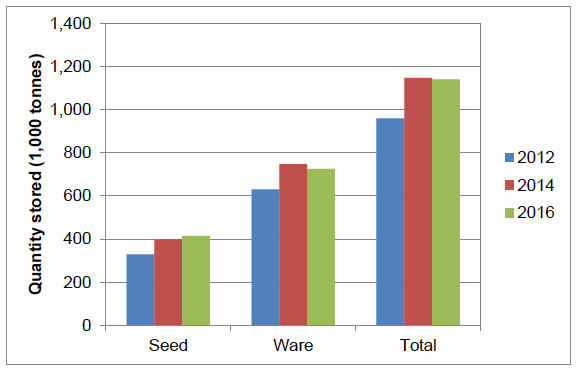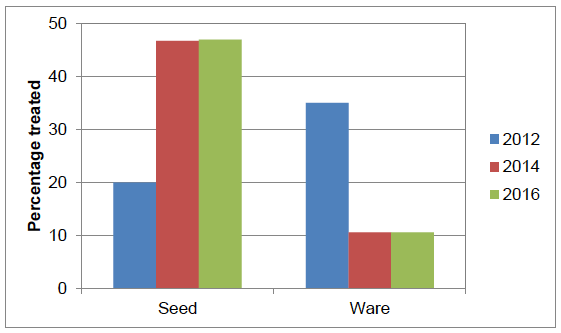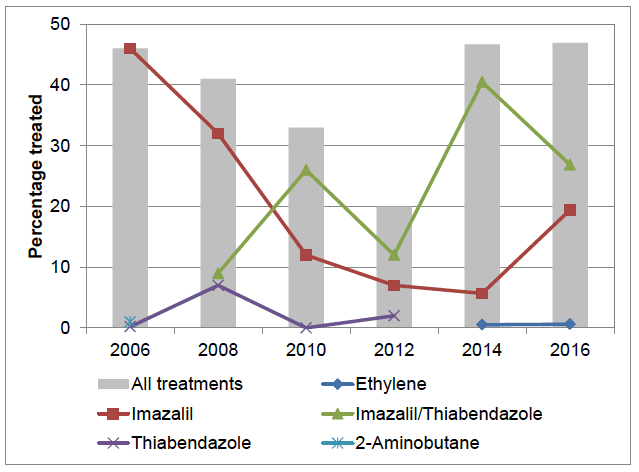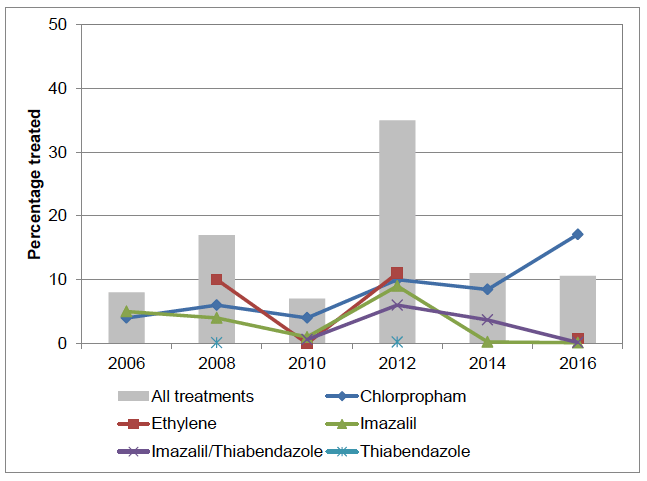Pesticide usage in Scotland: arable crops and potato stores 2016
This publication presents information from a survey of pesticide use on arable crops and potato stores in Scotland during 2016.
This document is part of a collection
General trends
Scottish potato storage
The total estimated quantity of potatoes stored in Scotland in 2016 (1,140,286 tonnes) was very similar to that reported in 2014 (1,146,682 tonnes). Both the 2016 and 2014 storage estimates were almost 20 per cent greater than 2012 (960,064 tonnes). The reduced storage in 2012 was a consequence of poor climatic conditions during the 2012 growing season (3), which resulted in yields 21 per cent below the 10 year average (2006 to 2016) for Scottish potato production (4).
The quantity of seed and ware potatoes stored was estimated to be 415,023 and 725,263 tonnes respectively ( Table 1). This represents a four per cent increase in stored seed potatoes, and a three percent reduction in storage of ware potatoes, from the previous survey in 2014 ( Figure 1).
In 2016, as in previous surveys, almost all potatoes surveyed were stored in boxes and very few bulk stores were encountered (<0.5 per cent of stored crops, Figures 5 & 7). Seed crops were mainly held in refrigerated stores (61 per cent) with the majority of the remainder in ambient ventilated stores (37 per cent) and a small proportion in unventilated stores (2 per cent) ( Table 1). The majority of seed crops were also held in refrigerated stores in both 2014 and 2012 (69 and 71 per cent respectively).
Ware potato stores were also mostly refrigerated in 2016 (77 per cent) with 21 per cent stored in ambient ventilated stores and two per cent in unventilated stores ( Table 1). Ware storage regimes in 2016 were also similar to those encountered in the previous two surveys; 66 and 78 per cent of ware tubers were held in refrigerated stores in 2014 and 2012 respectively.
Figure 1 Estimated total potato storage in Scotland 2012-2016

Pesticide usage
Seed potatoes
The proportion of stored seed potatoes treated with a pesticide in 2016 was the same as in 2014 (47 per cent) ( Table 1, Figure 2). This was an increase from 2012, when 20 per cent of seed crops received a store treatment. In 2012, despite the difficult growing season, the quality of seed potatoes harvested in Scotland was good (5) and pesticide use was around half of that encountered in the previous decade of surveys (6). With the exception of 2012, the proportion of seed potatoes receiving a pesticide treatment in the store has been fairly stable over the last decade ( Figure 3).
Figure 2 Percentage of stored potatoes treated with pesticides in Scotland 2012-2016

The majority (>99 per cent) of the pesticides used in seed potato stores were fungicides ( Figure 3, Table 2). In 2016, the most commonly used fungicide was a formulation of imazalil/thiabendazole which was applied to 27 per cent of seed crops, whilst imazalil alone was applied to 19 per cent. In 2014, these compounds were applied to 40 and 6 per cent of the crop respectively. The reason for the reduction in imazalil/thiabendazole use, and resultant increase in imazalil, is due to changes in pesticide approval. Imazalil/thiabendazole lost approval in 2015, with a final marketing and sale date of 30 th June 2016; which was prior to the 2016 potato store treatment period. However, the final use date of 30 th June 2017 allowed some growers to use their remaining stocks on the tubers harvested in 2016.
As in 2014, a small proportion (1 per cent) of stored potatoes, were treated with ethylene. Ethylene, which is generated from ethanol, is not approved as a plant protection product for stored seed potatoes. However it is approved as a commodity substance for plant growth regulation for post-harvest crops under COPR (7).
Figure 3 Percentage of stored seed potatoes treated with a pesticide in Scotland 2006-2016

Ware potatoes
As with the seed crop, the overall proportion of ware potatoes treated with a pesticide in store in 2016 was the same as in the previous survey (11 per cent) ( Table 2, Figure 4). Very few fungicide applications were encountered on ware potatoes (<1 per cent of stored crop). Historically, with the exception of 2012, which was an outlier, less than five per cent of stored ware potatoes have been treated with a fungicide over the last decade.
The majority of the pesticides used in ware stores were growth regulators, which are used for sprout suppression. The estimated percentage of the ware crop treated with a growth regulator in 2016 doubled from 2014, almost exclusively due to increased chlorpropham use (applied to 8 and 17 per cent of potatoes in 2014 and 2016 respectively. In recent surveys use of chlorpropham appears to be becoming more prevalent, with greater use recorded than ethylene, which was the principal sprout suppressant formulation prior to 2014. However, the use of growth regulators has shown variation over time, as have the compounds encountered ( Figure 4) and it's difficult to interpret trends within this data series.
Figure 4 Percentage of stored ware potatoes treated with a pesticide in Scotland 2006-2016

Contact
There is a problem
Thanks for your feedback